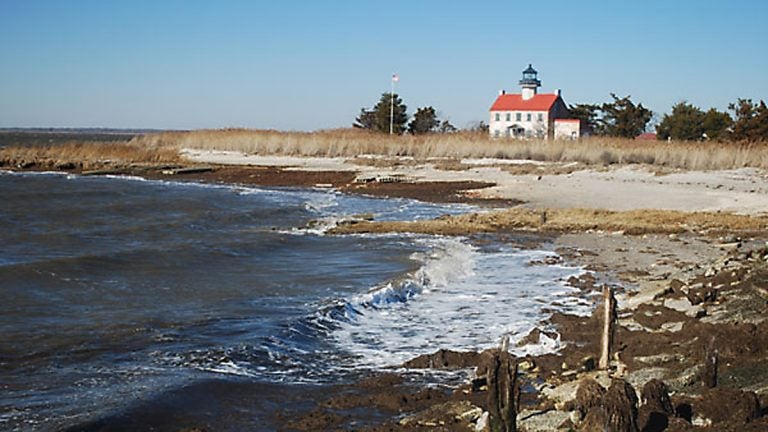Restoration planned for Delaware Bay beaches to make them safer for wildlife

Globally important populations of shorebirds and horseshoe crabs will get extra protection starting this year with the restoration of more beaches on New Jersey’s Delaware Bay shore, where Hurricane Sandy devastated some spawning grounds and feeding areas.
Contractors are expected in coming weeks to begin work at the first location — Thompson’s Beach, on a remote stretch of the Cumberland County shore, where rubble and shattered bulkheads will be removed and 40,000 cubic yards of sand will be dumped to rebuild a spawning ground for thousands of horseshoe crabs.
Four more beaches and a marsh are due for restoration over the next two years in a federally funded $5.1 million operation on behalf of the American Littoral Society and the Conserve Wildlife Foundation of New Jersey.
Officials aim to repeat successful restoration work done a five other Delaware Bay beaches that were destroyed by Sandy but where crabs and birds returned to spawn and feed in new sand over the last two seasons.
Crabs laid more eggs on the restored beaches than they did at non-restored locations, providing food for migrating shorebirds such as the red knot and the ruddy turnstone, according to Larry Niles, a consulting biologist who designs and manages the beach-restoration program.
Niles, a veteran wildlife biologist who previously headed the endangered species program at New Jersey’s Department of Environmental Protection, said the number of horseshoe crabs and the density of their eggs were significantly higher at the restored beaches.
He told the biennial meeting of the Partnership for the Delaware Estuary, a nonprofit that coordinates the work of local environmental groups on behalf of the U.S. Environmental Protection Agency, that the restoration project will build oyster reefs to reduce the impact of waves, and will work to raise the level of abandoned marshes so that they no longer draw water over the beaches during storms.
Recognizing the increased threat of big storms and sea-level rise, the project will also maintain the beaches over time rather than conducting one-off repairs, Niles said.
“We are not taking the position that when you have created a sandy beach, you can walk away,” he told those attending the meeting held at a Cape May hotel.
He is seeking to build local support for the project, and for conservation in general, by improving public access to the beaches where restoration will take place.
Better public access to beach – with a trade-off
At Thompson’s Beach, where a rough access road across the marshes is currently blocked by a locked gate, contractors will create a parking lot for fishermen and others who can use the beach for the 11 months of the year when the shorebirds are gone. In return, local officials at Maurice River Township readily agreed to rule the beach off-limits during the crab-spawning season in May, Niles said.
“You can’t have good conservation unless people have some material benefit from it,” he said.
The beach restoration represents the latest step in a years-long effort to prevent the extinction of shorebird species that depend on eating crab eggs during their migratory stopover on the bay beaches.
Thanks to a ban on horseshoe-crab harvesting on New Jersey beaches, the bay’s population of red knot, a 5-ounce bird that migrates from southern Argentina to Arctic Canada via the Delaware Bay beaches each spring, is off the lows seen in the early 2000s and has recently stabilized at about 25,000.
But that’s less than a third of the 80,000-bird level that biologists consider sustainable, and well below its peak of about 92,000 in the 1980s, Niles said.
Although the modest increase has eased fears of imminent extinction, the bird is still vulnerable to catastrophic events like major storms in its Arctic breeding grounds, oil spills in its wintering areas, and the erosion of beaches on its migratory route.
With restrictions on the crab harvest, the focus of concern about the birds’ survival has recently shifted to the effects of climate change – sea-level rise and bigger storms like Sandy – that have eroded or destroyed the beaches on which the birds depend for food and rest during their long migrations.
“You are not going to see knots go down to the last bird,” Niles said in an interview at Thompson’s Beach. “You might get to the point where there are 5,000 left but those 5,000 could be lost in a moment because of a storm or whatever.”
While the knot has become well-known because of extensive media coverage, and was recently listed as threatened under the federal Endangered Species Act, other shorebirds that use the bay beaches have also suffered a sharp decline, Niles said. He cited the ruddy turnstone, whose numbers are down to 14,000 from some 150,000 during the 1980s.
The ruddy turnstone “took a bigger hit than the knot — it’s just that we haven’t created enough focus on their status,” Niles said.
Although other shorebird species deserve more attention, they are in a better position to get public support because of the public attention paid to the red knot, he said.
“It’s going to take a long time to build the case for the ruddy turnstone but that’s why the knot is so important, because it puts the focus on the group of species,” he said.
The total population of six species of shorebirds passing through the bay each spring has dropped to an estimated 250,000-300,000 from some 1.5 million in the 1990s because of the previous over-harvest of horseshoe crabs for commercial fishery bait, Niles said.
Horseshoe crabs still threatened
Despite New Jersey’s ban and a crab-management plan by the Atlantic States Marine Fisheries Commission, Niles said the crabs are still being taken for bait and for a medical product in their blood.
There are signs that the fishing industry in Maryland and Virginia is legally harvesting crabs that spawn on Delaware Bay beaches but migrate to waters off those states in the winter, he said.
“Now, Virginia and Maryland are able to take crabs from off their shores and they get to pretend that they’re not from Delaware Bay,” he said. “There is no other significant population of horseshoe crabs breeding on the Atlantic Coast except for the Delaware Bay.”
Niles estimated that some 500,000 male crabs and 150,000 females are harvested each year for their blood, which contains LAL, an extract used to ensure that medical products such as intravenous drugs and vaccines are free of contamination.
Crabs are bled and then returned to the ocean in an operation that may kill as many as half of them, he said.
The medical harvest has cut the number of females to about 4 million from about 12 million in the 1990s, he said.
“There’s no evidence of recovery in the crab population,” he said. “We’re not going to increase the bird population until the crab numbers start increasing.”
Marin Hawk, Fishery Management Plan Coordinator for the Atlantic States Marine Fisheries Commission, said the bay’s population of horseshoe crabs has been “stable” for the last 10 years.
“The commission doesn’t speculate on all the different things that could be impacting the population,” she said. “Our model takes into account the horseshoe crab abundance and the shorebird abundance. As far as the commission is concerned, it’s managed at a sustainable level.”
She declined to comment on Niles’s assertion that the population is being diminished by harvesting in waters off Maryland and Virginia, and said the management plan will be reviewed in 2018 after it has been operating for five years.
________________________________________________
NJ Spotlight, an independent online news service on issues critical to New Jersey, makes its in-depth reporting available to NewsWorks.
WHYY is your source for fact-based, in-depth journalism and information. As a nonprofit organization, we rely on financial support from readers like you. Please give today.




